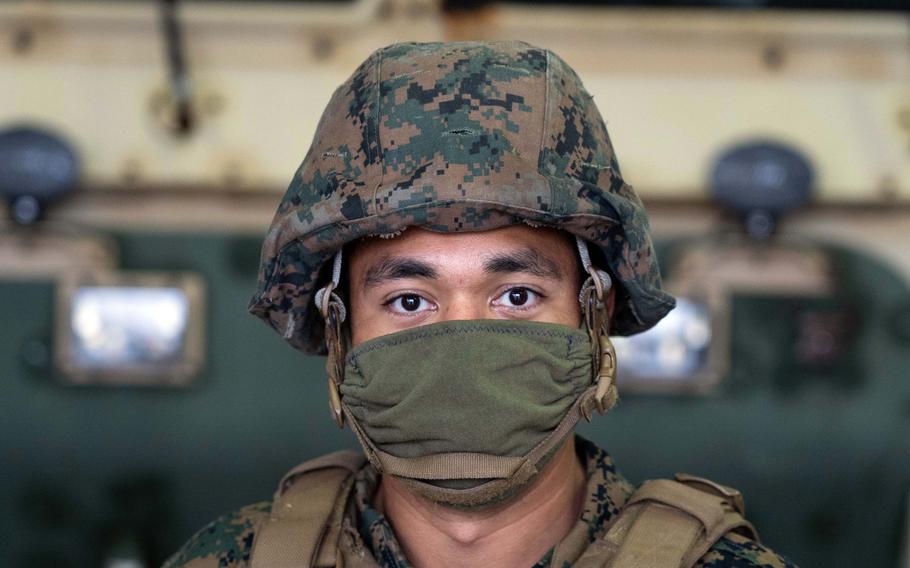
Marine Lance Cpl. Michael Ottinger wears a homemade face covering while posing for a photo on Camp Foster, Okinawa, Japan, April 7, 2020. (David Esparza/U.S. Marine Corps)
Stars and Stripes is making stories on the coronavirus pandemic available free of charge. See other free reports here. Sign up for our daily coronavirus newsletter here. Please support our journalism with a subscription.
Balaclavas may be OK, but ski masks may not be, depending on which uniform a service member wears, under service-specific guidance on the Pentagon’s new facial covering requirements.
On Sunday, the Defense Department began requiring everyone on DOD property to wear face coverings in public or work settings, “to the extent practical,” when six feet of physical distance cannot be maintained. In command-level guidance, U.S. European Command has noted that includes inside government vehicles, and U.S. Central Command said it includes hallways inside buildings.
The Army, Air Force and Navy have all indicated they would be providing official uniform masks. Until then, they and the other services have outlined options that meet some basic requirements.
Here’s how the guidance breaks down:
CDC compliance All the services agree that the face coverings should comply with Centers for Disease Control and Prevention guidance — that they fit snugly and comfortably against the side of the face, be secured with ties or ear loops, allow unrestricted breathing, include more than one layer of cloth and be machine washable without being damaged or losing shape.
Limited use of surgical masks and respirators Most services prefer masks fashioned from bandanas or T-shirts to the use of surgical masks or N95 respirators, except for those working in medical environments. In an apparent exception, the Navy allows “medical or construction type masks” without caveat in its formal guidance.
The Marine Corps, which relies on Navy medical workers, forbids the purchase or use of N95 or surgical masks to meet the new DOD requirement. The Coast Guard guidance states that surgical masks should be used only as a “last resort and only with command concurrence” when local supplies are adequate, but N95 respirators are forbidden for broader use.
Interim options All the services mentioned use of items such as scarves and bandanas or, in the case of the Army, Air Force and Marine Corps, government-issued neck gaiters or balaclavas. The Marine Corps forbids the use of full masks, such as field protective masks and ski masks.
Homemade masks should “present a neat and professional military appearance,” the Marine Corps states, and cannot include “demeaning or derogatory logos, profanity, racist, sexist, printed wording, eccentric designs, offensive script, wrongful drug abuse, dissident or protest activity, or imagery.”
Similarly, the Navy and Air Force state that masks should be “conservative” in appearance, professional and inoffensive. The Coast Guard prefers solid colors such as navy blue, black, gray or white.
Though it did not specifically bar any colors or patterns, Army guidance warned Monday that soldiers should not make homemade face coverings out of Army Combat Uniforms or other materials that have been chemically treated. No “skull and crossbones,” but maybe brown or something “somewhat professional,” said Sgt. Maj. of the Army Michael Grinston in a Facebook live event Tuesday.
Additional warnings While not required to wear the masks in their residences, Marines and their families were encouraged to do so, but children under age 2 and others who can’t remove the mask without assistance should not wear them, the Marine Corps said.
Face coverings should not be shared and users should avoid touching the areas near their noses and mouths when removing the covering, the Coast Guard warned. When not being worn, the covering should be stored somewhere only the user will touch it, to avoid contaminating surfaces. And users should wash their hands before and after handling the mask.
The masks are part of an overall approach to preventing the spread of the COVID-19 disease, including social distancing and limiting movement, the Coast Guard said in its guidance.
“Members should not assume that face covering is an effective, stand-alone method of protection,” said the memo signed by Rear Adm. Dana Thomas, the service’s chief medical officer. “Be vigilant and work to avoid large groups, maintain social distancing, and don’t let your guard down.”
garland.chad@stripes.com Twitter: @chadgarland